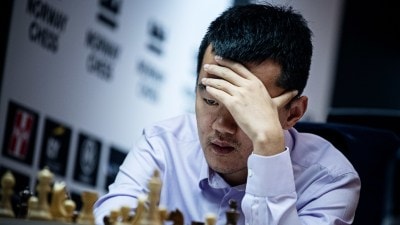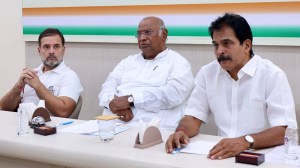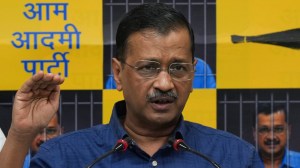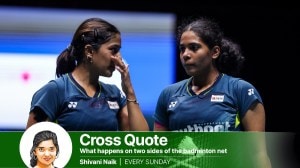- India
- International
Explained: What is cricket’s ‘fake fielding’ law, and how did Fakhar Zaman get conned by de Kock?
Pakistan opener Fakhar Zaman's dismissal by South Africa's Quinton de Kock has thrown open a debate about a contentious aspect of cricket: 'fake fielding'. What constitutes fake fielding, and what is the penalty for it?
 Pakistan batsman Fakhar Zaman plays a shot as South Africa's wicketkeeper Quinton de Kock watches on during the second One Day International cricket match between South Africa and Pakistan at the Wanderers stadium in Johannesburg, South Africa, Sunday, April 4, 2021. (AP/PTI Photo)
Pakistan batsman Fakhar Zaman plays a shot as South Africa's wicketkeeper Quinton de Kock watches on during the second One Day International cricket match between South Africa and Pakistan at the Wanderers stadium in Johannesburg, South Africa, Sunday, April 4, 2021. (AP/PTI Photo)On a day when Pakistan opener Fakhar Zaman posted the highest individual score for a chasing team in an ODI — 193 off 155 balls — his dismissal threw open a debate about a contentious aspect of cricket: ‘fake fielding’. As Pakistan lost to South Africa by 17 runs in the second ODI at Johannesburg, Zaman’s run-out saw the cricketing world talk about yet another ambiguous aspect of the game that is in conflict with the ‘spirit of the game’ and laws governing the sport. Like Mankading, ‘fake fielding’ too triggers outrage among those who call this act of gamesmanship unethical.
Newsletter | Click to get the day’s best explainers in your inbox
What was the incident?
In the first ball of the 50th over during Pakistan’s chase, Zaman hit a Lungi Ngidi delivery to Aiden Markram at long-off. As the opener was coming back for a second run, South Africa wicketkeeper Quinton de Kock pointed at the bowler giving the impression that the throw was coming to the non-striker end. With his back to the fielder, Zaman, going by de Kock’s signal, slowed down as he moved towards the striker’s end. However, the throw was actually aimed at the wicket-keeper and with Zaman ambling to the crease he was run out. Although Pakistan needed 31 runs for victory in the final over, Zaman had scored his last 90 runs off just 48 deliveries and he was the last recognised batsman standing.
Fakhar Zaman views on his run out and Quinton De Kock act.
Post Match Press Conference via @OfficialCSA pic.twitter.com/vHzjA2CQLr
— Abdul Ghaffar (@GhaffarDawnNews) April 4, 2021
Did de Kock’s action fall under deception?
The Marylebone Cricket Club (MCC) is the custodian of the Laws of Cricket and its 41.5.1 Law states: “It is unfair for any fielder wilfully to attempt, by word or action, to distract, deceive or obstruct either batsman after the striker has received the ball.”
What is ICC’s stand on this?
A “deliberate attempt to distract striker” constitutes “unfair play” under clause 41 of the International Cricket Council’s (ICC) “Standard Test, ODI and T20I Playing Conditions”. This is as per the ICC Code of conduct for players and player support personnel.

What is the fake fielding penalty?
Umpires are authorised to award the batting team a five-run fake fielding penalty, although this law is open to interpretation. In fact, there remains a serious ambiguity in terms of what constitutes fake fielding and what is not.
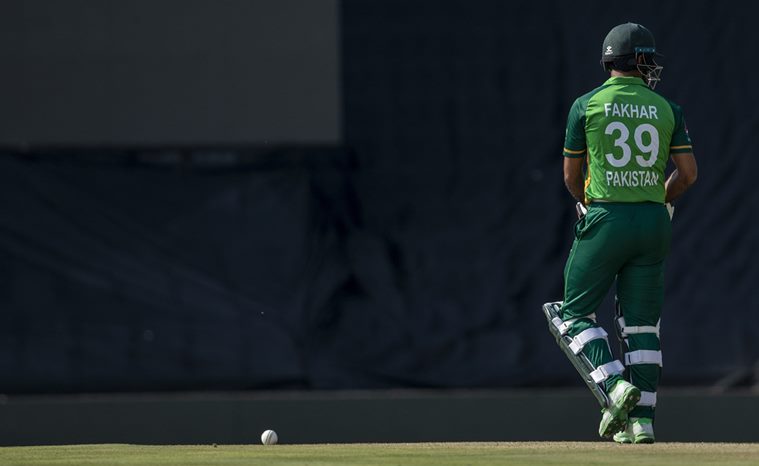 Fakhar Zaman. (AP Photo: Themba Hadebe)
Fakhar Zaman. (AP Photo: Themba Hadebe)
Any previous incidents?
Jonny Bairstow’s ostensibly fake attempt to run out Steve Smith on the second day of the fifth Ashes Test in 2019 had sparked a debate. Bairstow made Smith dive despite not having the ball. On-field umpires Marais Erasmus and Kumar Dharmasena, however, didn’t award extra five runs to Australia.
In 2015, former Sri Lanka captain Kumar Sangakkara made Pakistan’s Ahmed Shehzad dive to save his wicket during an ODI, as he attempted to take the bails off despite the throw not reaching him. Back in 2015, though, the fake fielding law wasn’t a part of the ICC playing conditions.
In 2017, Australia’s Marnus Labuschagne was penalised for trying to fake a throw without having the ball in hand to prevent a run in the JLT Cup (Australia’s domestic 50-over tournament).
Why is the ambiguity?
“As with any law like this, it is always going to be for the umpires to decide what is ‘deliberate’ and what is ‘deception’,” MCC’s Laws of Cricket manager Fraser Stewart told ESPNcricinfo in 2017. The ambiguity lies in the scope for interpretation, as the directive is not clear-cut.
What has been the reaction to Zaman’s dismissal?
Fans on social media have by and large condemned de Kock’s action. Former Pakistan fast bowler Shoaib Akhtar has asked if it was contrary to the spirit of the game. “Was this run out by @QuinnyDeKock69 against the spirit of the game? I’d leave it for you guys to decide,” Akhtar tweeted.
More Explained
Must Read
EXPRESS OPINION
Jun 02: Latest News
- 01
- 02
- 03
- 04
- 05











